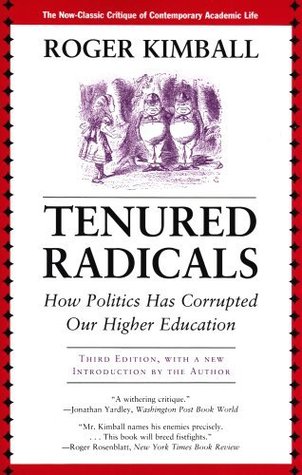The state of higher education in our country is best passed over in silence, in order to avoid both useless exasperation and any provocation of “reform.” The mess we are in is the result of a parade of fraudulent reforms and movements, of a national, political, and social corruption so pervasive that I see no basis for hope of the restitution of norms in the education industry. The corruption is systemic and has long since metastasized to a point past redemption. Harboring no dreams of an armed uprising by the “people”—only the homeless and the dead have evaded the totalitarian mindlessness of “education”—I only suppose that there might be some groups of private individuals who may revive ancient ideals of learning by banding together in secret.
Roger Kimball has not chosen silence as a way of dealing with outrage. And since he has taken one of the most disagreeable of topics for his exposition, the sheer readability of Tenured Radicals is greatly to his credit. Who would have expected that a book on the tendentious longueurs of pompous ideologues would be so funny? But so it is.
Mr. Kimball’s method for dealing with a host of inversions, gnosticisms, non sequiturs, mendacities, opacities, and howlers is a sly if simple form of judo: he quotes them. Reading the book will show just how effectively Kimball’s reproductions of abuse and exposures of betrayal work together to support his uniting theme. His quotation of Margaret Ferguson of Columbia University is a representative example:
. . . [Professor Ferguson] pointed out that success in the university, especially for women and minorities, comes at a tremendous psychic cost. She confided that she herself had had to internalize a code of decorum and manners to succeed in the academy; almost sadly, she assured the audience that she was not going to stand and swear at us . . . much as she might want to at the moment; part of the price of being there on the podium was being trained not to do such things. And in case we didn’t get it the first time around, she reminded us that she regarded the real problems in the academy as political problems: questions about the canon or pedagogy or education in general were merely fronts for political issues.
Roger Kimball does a similar number on Professor E. Ann Kaplan of SUNY/ Stony Brook, whose probing and recondite analyses of rock videos he cites with force and point:
Who would have thought it possible that a woman entrusted with teaching college English and directing a humanities center at a major university would make her scholarly reputation writing about “Smokin’ in the Boys’ Room,” the rock videos of Madonna, and “Gender Address and the Gaze in MTV”?
Roger Kimball’s dissections of absurdity remind me of some of the performances of Richard Mitchell, the “Underground Grammarian,” and there’s a sense in which his study is related to William F. Buckley, Jr.’s God and Man at Yale of some forty years ago. Kimball finds the academy neither ivory nor towering, but a sanctuary for those whose professing dishonors and degrades the Western culture that their institutions were founded to uphold.
The truth is that when the children of the sixties received their professorships and deanships they did not abandon the dream of radical cultural transformation; they set out to implement it. Now, instead of disrupting classes, they are teaching them; instead of attempting to destroy our educational institutions physically, they are subverting them from within. Thus it is that what were once the political and educational ambitions of educational renegades appear as ideals on the agenda of the powers that be. Efforts to dismantie the traditional curriculum and institutionalize radical feminism . . . now typically issue from the dean’s office or Faculty Senate, not from students marching in the streets.
Kimball is quite right to insist that the present state of confusion is often to be attributed to academic administrators, and not only to faculty members. But I question whether he should assume with such facility that there was an identifiable time when “the canon” and the heritage of Western culture were successfully transmitted by our nation’s colleges and universities to eager eyes and ears. The great tradition of beer blasts, panty raids, and football games was not exactly one of Oxonian elevation, to my mind. Nor should Kimball assume either that there’s any monolithic “tradition” to be identified, but rather many countervailing strands of passionate controversy instead.
Even so, Roger Kimball’s Tenured Radicals is an energetic and entertaining essay. Kimball is essentially right about the decay of academic discourse, and he is quite correct in identifying our nation’s elite schools as sources of contempt for this country and hatred for the great cultural achievements of the past. The legacy we identify with Dead White European Males is not “professed” but profaned by academics obsessed with racial quotas, questions of “gender,” the control of thought, and the suppression of free speech. Does anyone suppose that the rapidly approaching anniversary of Columbus’s first voyage will be celebrated as a heroic achievement and as a positive good, or that the consequent introduction of Christianity will be presented as a civilizing transformation for the better? Stand by for many learned analyses of “the imperial myth of cannibalism.”
Roger Kimball’s Tenured Radicals accurately assesses the present tone of academic life at some of our elite institutions. What’s more, Kimball comprehends the implications of leftwing politics and the deep need for a rejection of the past by the professors of it. To the national debate on the curriculum and the canon, he has made an important contribution.
[Tenured Radicals: How Politics Has Corrupted Our Higher Education, by Roger Kimball (New York: Harper & Row) 204 pp., $18.95]

Leave a Reply